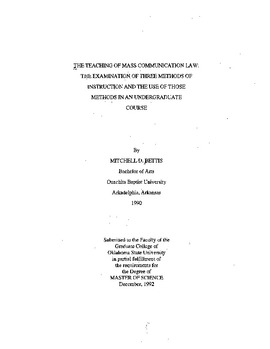| dc.contributor.author | Bettis, Mitchell D. | |
| dc.date.accessioned | 2014-11-03T16:06:22Z | |
| dc.date.available | 2014-11-03T16:06:22Z | |
| dc.date.issued | 1992-12-01 | |
| dc.identifier.uri | https://hdl.handle.net/11244/13424 | |
| dc.description.abstract | It may be the influence from the field of advertising, I'm not sure. Somewhere along the way I developed the ideology that how infomi.ation is presented in the classroom is just as important as the course's content. That line of thought, combined with my interest in media law, led to this study. , A challenge faced by communication law professors is how to organize a large body of information and present it in some understandable manner so that students will retain at least a portion of the information afterexitingthe classroom door. This is no easy task considering the growing number of court decisions affecting free speech and the free press and the unique but subtle differences between each of the decisions. The three methods of classroom instruction for a media law course that were included in this study were the Socratic� ~ethod, theoretical framework approach, and the media studies method. Each method has unique characteristics that set it apart from the others. Because the body of information concerning communication law continues to grow, educators need to be aware of and open to the different methods of instruction for such a course. As precedents pile upon precedents, both new and veteran communication law professors also need to understand the various resources that are available. Without examining new techniques an~ new resources, educators will never be aware of the alternatives available to them. I believe that it is essential for educators to constantly reevaluate how they present information in their classroom. To teach a class the same way every semester year after year just because "we've always done it that way" may be the most damaging attitude in higher education. If our goal is to disseminate information and encourage students to do further study on their own, we must take a critical look at what we are doing and be willing to make some radical changes. | |
| dc.format | application/pdf | |
| dc.language | en_US | |
| dc.publisher | Oklahoma State University | |
| dc.rights | Copyright is held by the author who has granted the Oklahoma State University Library the non-exclusive right to share this material in its institutional repository. Contact Digital Library Services at lib-dls@okstate.edu or 405-744-9161 for the permission policy on the use, reproduction or distribution of this material. | |
| dc.title | Teaching of mass communication law : the examination of three methods of instruction and the use of those methods in an undergraduate course | |
| dc.type | text | |
| osu.filename | Thesis-1992-B565t.pdf | |
| osu.accesstype | Open Access | |
| dc.description.department | Mass Communications | |
| dc.type.genre | Thesis | |
